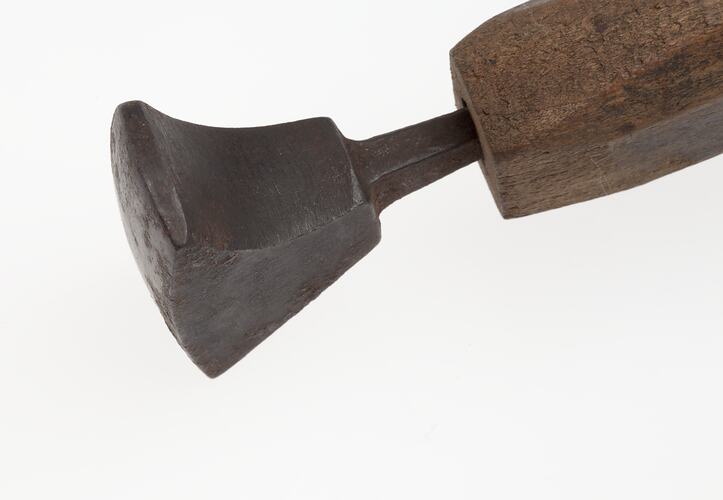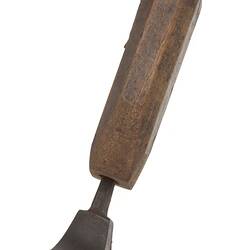Summary
This plain type, single beaked glazing iron tool is one of many belonging within Stanio Fancoff's shoemaking tool set. These apparatuses were used hot after applying wax, inks, special polishes or heel balls to give the leather surface lustre, particularly within the soles and heels. The glazing iron was an integral part of Stanio's shoemaking tool kit as it provided him with the means to achieve greater aesthetic enhancement within his shoemaking craft.
Stanio Ivanoff Fancoff was born in 1908 in Bojentsi, a small village in Bulgaria. At age 11, Stanio left home to learn the shoemaking trade. In 1929, he immigrated to Melbourne, settled in Fitzroy and began to work for the V.G. Zemancheff & Sons basket shoe factory in South Melbourne. In1936, he married Dorotea Georgi Touzou who had recently arrived in Australia. Around this time, Stanio set up his own shoemaking business from home, with Georgi, her cousin and sister weaving the shoes which he then assembled. Select shoe samples were then taken to Sydney and Tasmania for sale. In 1942, Georgi and Stanio moved to Broken Hill for Georgi's health; there daughter Nancy was born and Stanio set up a shoe shop/factory. In 1945, Georgi died and by 1950 Stanio and Nancy had moved to Adelaide where he again opened a shoemaking business and shop. He passed away in 1978, having been in the shoemaking business for 59 years. This collection documents his migration and working life experiences.
Physical Description
A single beaked Iron glazing tool mounted onto a wooden handle. The rectangular medium brown wooden handle edges have been removed to provide the handle with an octagonal appearance. A small dark brown leather strap with one button hole has been double tacked to the wooden handle's lower third portion. The iron head tool appears with a single beak format. The metal surface is dark coloured, possibly resulting from past use of varnish or waxing application.
Significance
This collection is significant in documenting a small migrant business as well as the fashion of a particular period. It is well provenanced and charts the application of trade skills in a new country. It also illustrates the stages of hand shoe manufacture from the 1930s, demonstrating the enduring nature of the tools and patterns that were used.
More Information
-
Collecting Areas
-
Acquisition Information
Donation from Nancy Vasileff, 21 Mar 2007
-
Past Owner or User
-
Classification
-
Category
-
Discipline
-
Type of item
-
Overall Dimensions
162 mm (Length), 45 mm (Width), 25 mm (Depth)
-
References
R.A. Salaman, 'Dictionary of Leather-working Tools c.1700-1950 and Tools of Allied Trades,' London: George Allen and Unwin (Publishers) Ltd, 1986 [Section 2: Boot and Shoe Maker pp18-185]. John Peacock. 'Shoes, The Complete Sourcebook,' London:Thames & Hudson Ltd, 2005. NAA holds file (online) on Vasil George Zemancheff, Fancoff's employer
-
Keywords
Boot & Shoemaking, Bulgarian Communities, Bulgarian Immigration, Immigration, Small Businesses, Tools



